
You can care for a cat for as low as $222 per year, but it’s common to spend about $1,150 annually. Read on for our detailed breakdown of your annual and lifetime costs.
In their oft-cited “Pet Care Costs” publication which was updated in 2021, the ASPCA (American Society for the Prevention of Cruelty to Animals) estimates that a new cat will cost $1,904 in their first year. With the costs of bringing a new cat into the family aside, the ASPCA determines determine that each successive year will cost $1,149.
How much does a cat cost? We’ve calculated the annual costs of cat litter, food, vet visits, and more, and found that you can keep a cat for as little as $385 the first year and $222 every successive year. Little luxuries like treats, good food, and new toys will add a few hundred dollars to that annual figure, bringing us closer to the ASPCA’s estimate. The most expensive lifestyles will likely add up to a few thousand dollars a year.
But everyday expenses aren’t cat guardians’ most serious financial concern. Medical emergencies and illnesses are the biggest expense to budget for, potentially adding $5,000 or more to your cat’s lifetime cost.
Let’s work our way through the costs of owning a cat, estimating both startup costs and the recurring costs that you’ll cover for the rest of your cat’s life.
Bringing Home a New Cat: One-Time Costs
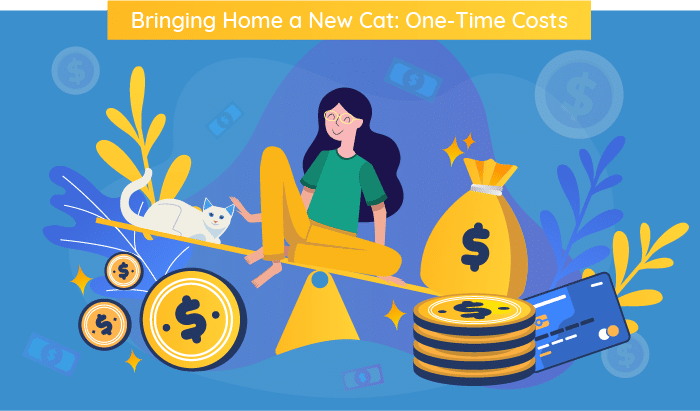
Free Cats
You’ll almost always have to spend money to raise a cat, but you can often bring one into your life for free. Cats are given away for free every day. Free cats come in all shapes, sizes, and ages. Sometimes they wander onto your porch and never leave. Sometimes you find them in trash cans or book drops.
While you won’t have to pay for these cats upfront, they may come with additional startup costs.
For example, you may have to cover the cost of spaying or neutering on your own. If you adopt an orphaned kitten, you’ll have to pay for kitten milk replacer. These kittens are often sick or flea-infested, so it’s likely that you’ll encounter some medical bills along the road to adulthood as well.
Adoption
$25 – $200
How much does it cost to adopt a cat? Animal shelters and other rescue organizations typically charge between $50 to $200 in adoption fees. If $50 sounds like a lot, keep your eyes open for special adoption events. Most rescue organizations run promotions regularly, during which they adopt out cats at reduced prices (some even waive the adoption fee entirely).
Shelter cats have already undergone checkups and have likely been treated for any medical conditions before they’re deemed adoptable. Spaying and neutering are also typically included in the adoption fee which helps reduce your initial cost.
Keep in mind that some shelters assign adoption fees on a sliding scale based on costs to get the cat ready for adoption.
The Animal Humane Society, for example, has a graphic on their website which shows a breakdown of costs for an adoptable kitten named Chicken Little. Chicken Little required $925 in care, which included exams, vaccinations, treatment, housing, and feeding for 8 weeks. The adoption fee was set at $255.
Breeder
$500 – $1,000 on average
If you buy your cat from a breeder, they’ll probably cost between $500 and $1,000, but the cost may be higher if you purchase one of the most expensive breeds.
While most breeders take the time to ensure that their kittens are healthy and in great condition before they go to a new home, they don’t always cover neutering and other medical costs.
Your cat’s breed affects how much they cost, both upfront and over the course of their life.
Some breeds aren’t particularly expensive to buy but have high maintenance costs due to breed-specific health conditions.
Here are some of the most expensive cat breeds and the health conditions they encounter most often:
| Breed Name | Average Cost | Common Health Conditions |
| Savannah | $1,200-$55,000 | None |
| Bengal | $1,200-$27,000 | Hypertrophic cardiomyopathy (HCM), eye disorders |
| Persian | $800-$7,500 | Polycystic kidney disease (PKD), progressive rod-cone degeneration (PRA), and HCM |
| Peterbald | $1,200-$5,000 | None |
| Russian Blue | $400-$3,000 | None |
| Sphynx | $200-$3,000 | Heart disease, respiratory issues, digestive problems |
| Scottish Fold | $200-$3,000 | Osteochondrodysplasia PKD, HCM |
| British Shorthair | $500-$1,500 | Hemophilia B, HCM |
Mixed-breed cats are typically the most economical option. Not only are they cheaper to buy, but mixed breed cats are less prone to health problems.
Additional One-Time Costs of Getting a Cat

The one-time costs associated with bringing home a new cat will vary. For example, if you’re getting a free kitten or a cat from a breeder, you may need to pay for spay/neuter surgery yourself. Certain costs like microchipping and ID tags are optional but recommended while others – like food bowls, bedding, and enrichment items – are considered necessities.
We’ve also included a category of costs that may be necessary when adopting a medically fragile or special needs cat.
Additional exams and diagnostics may be recommended when adopting pregnant cats, cats with prior injuries, or cats with chronic conditions like FIV or FeLV. Adopting a special needs cat may require you to make one-time changes to your home to improve access for cat.
Necessities
- Food and Water Bowls – $15
- Litter Box – $25
- Litter Scoop – $10
- Carrier – $40
- Bed – $30
- Cat Tree – $50
- Scratching Post – $30
- Cat Nail Clippers – $10
- Cat Brush – $15
- General Exam – $45 – $50
- First-Year Vaccinations – $115 – $210
Optional but Recommended
- Spay/Neuter – $50 – $250
- ID Tag – $10
- Collar – $10
- Microchip – $30 – $50
- Teeth Cleaning – $150 – $500
Potential Costs for Special Needs Cats
- Elevated Bowls – $20
- Cat Harness – $15
- Cat Sling – $25
- Cat X-Ray Cost – $100 – $250
- Cat Ultrasound Cost – $250 – $500
- Cat Steps or Ramps – $50 – $300
Bringing home a new cat on a budget? Check out our New Cat Essentials (Budget Edition) video on the Cats.com YouTube channel.
Medical Annual Expense Breakdown
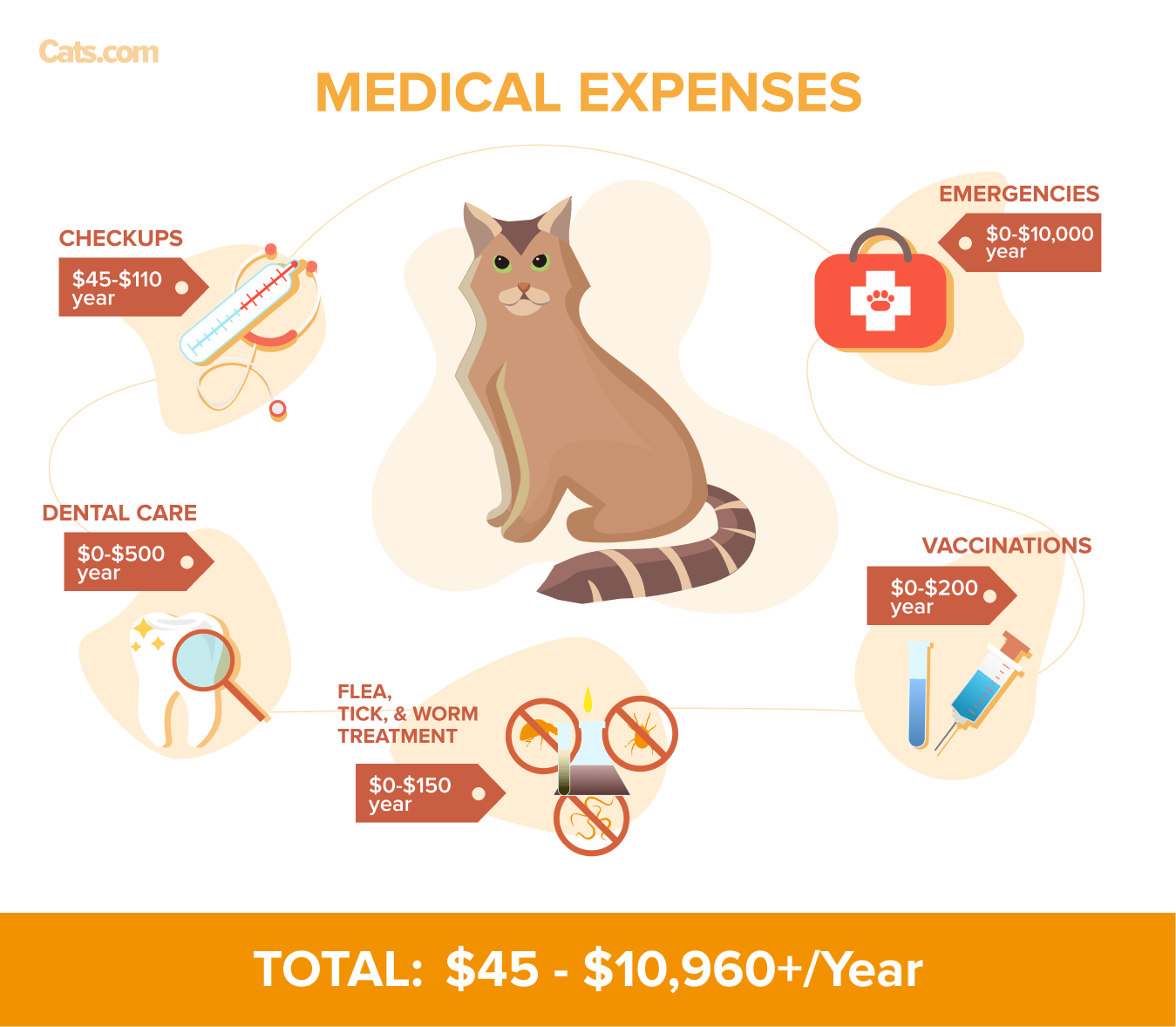
Annual Medical Expenses
Veterinary bills can take a big chunk out of your cat care budget, especially if your cat has a serious illness or injury. Here’s a breakdown of both routine and emergency veterinary care costs.
Checkups
$45-$110/year
Lemonade Insurance suggests a basic vet visit costs between $45 and $55, excluding the cost of diagnostics. Fecal exams cost $25 to $50 and heartworm tests cost about $50. It’s generally recommended that cats visit the vet’s office once a year until they reach their senior years.
Once your cat is somewhere between 9 and 11, most vets recommend that you take them in for a checkup every six months. Some veterinarians charge more for geriatric exams which may or may not include diagnostic tests like urinalysis, bloodwork, or x-rays. These exams cost an average of $85 – $110.
Dental Care
$0-$500/year
If you want to keep your cat’s dental care bills low, invest in a cat toothbrush and toothpaste as soon as you bring them home. A toothbrush and cat toothpaste cost around $15 and are a great investment in your cat’s health and your financial future.
Periodontal disease affects many, if not most, middle-aged and senior cats, and it brings with it a sea of other issues. Once your cat’s teeth are covered in calculus, it will take a professional dental cleaning to get rid of it. That will cost you between $150 and $500 every time.
And if you don’t catch it early enough, periodontal disease will lead to organ disease and its multi-thousand-dollar treatment paths.
Cat Vaccinations Cost
$0-$200/year
In addition to your kitten’s first-year vaccinations, many veterinarians recommend booster shots. Which shots your vet recommends may vary depending on where you live and whether your cat has access to the outdoors. Some cat vaccinations are given annually, like feline leukemia (FeLV) for high-risk cats, while others only need to be given every three to five years, like rabies.
Individual vaccines generally cost between $25 and $50. Depending on your cat’s age, lifestyle, and health status, your annual vaccination costs could range from $25 to $200.
Treatments for Fleas, Ticks, Worms, and Mites
$0-$150/year
If you live in an area with fleas or ticks and your cat spends time outdoors, you may have to treat them with insecticides. Flea and tick prevention can be costly, but it’s not an expense you want to skimp on. Cats who eat wild prey may need dewormers. These treatments aren’t necessary for most indoor cats but are highly recommended for outdoor cats.
Emergency Medical Expenses
$0-$10,000+/year
According to Dr. Louise Murray, vice president of the Bergh Memorial Animal Hospital in New York City, expensive emergency medical bills are something worth preparing for. She says that “owners will likely incur at least one $2,000 – $4,000 bill for emergency care at some point during their pet’s lifetime.”
Here’s a Breakdown of How Much It Might Cost To Treat Common Conditions.
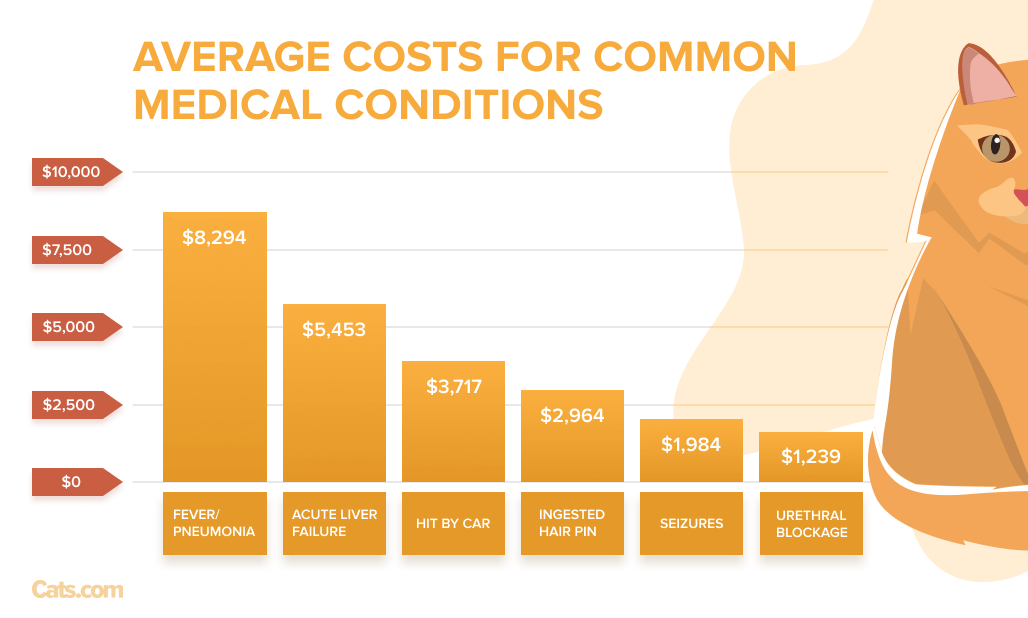
Continuing Medication for Extended or Chronic Illness
If your cat develops cancer, diabetes, chronic kidney disease, or another serious illness, you can expect to spend a lot of money on continuous treatment. Those expenses will be a way of life for a long time, presumably for the rest of your cat’s life.
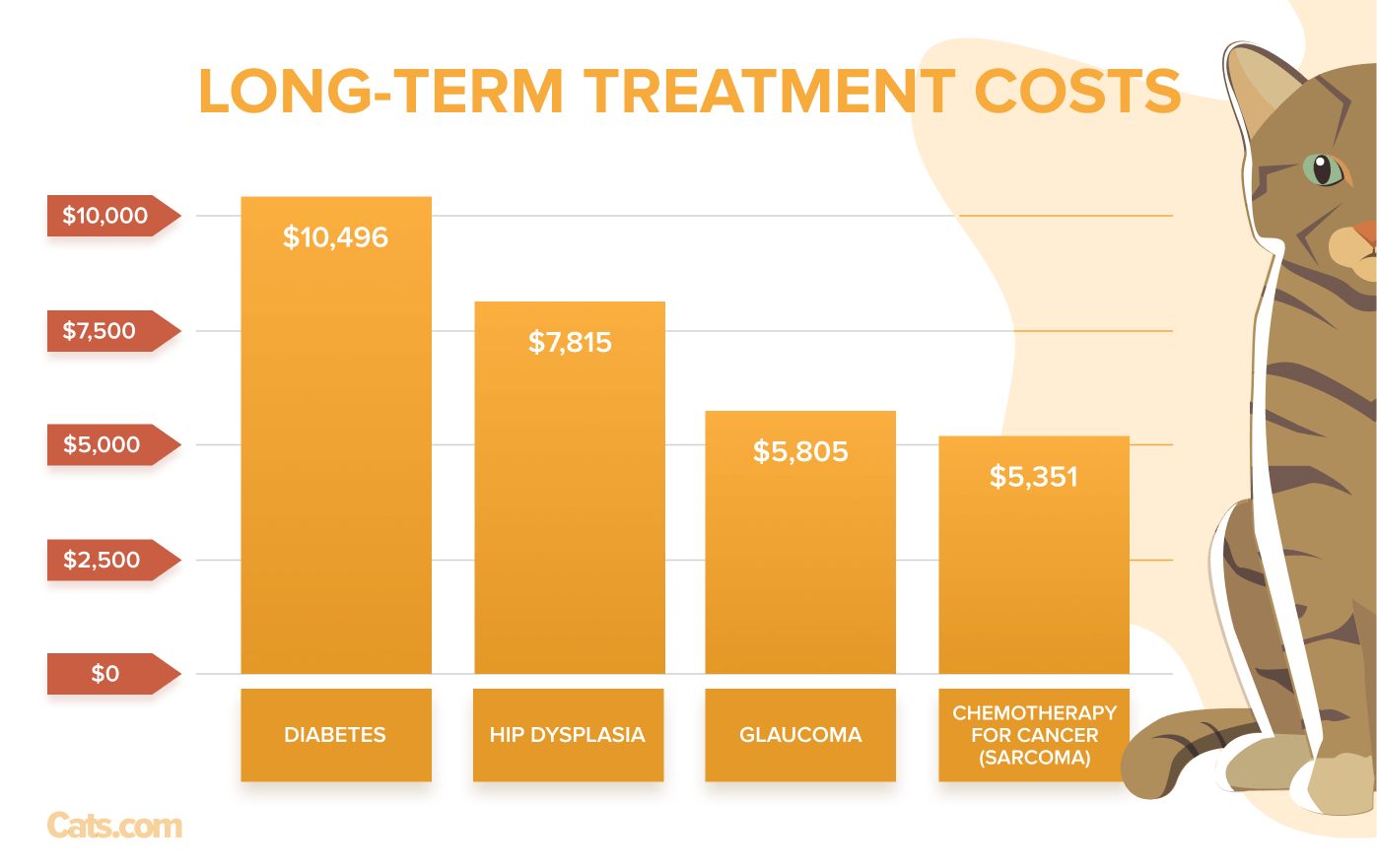
Pet Insurance
$0-$552/year
The big variable here is whether or not you have pet insurance. If you buy pet insurance for your cat early in life, your annual medical bills will probably be relatively low even with a serious condition at play.
That being said, there’s no guarantee pet insurance will help you save money. You’ll have to pay your premium every month and meet certain deductibles – if you never use the plan, you’re paying for nothing.
Pet insurance rates depend on how old your cat was when you took out a policy, where you live, your cat’s breed, and a variety of other factors. According to Forbes, pet insurance premiums for cats costs between $12 to $46 per month, or an average of $28 per month for $5,000 in annual coverage. Most pet insurance plans cover costs related to accidents or illnesses, often both. Comprehensive plans that include preventive care are more expensive.
While pet insurance companies are a dime a dozen, Lemonade is unique in that they’ve optimized their product for the modern pet owner. Lemonade offers competitive pricing, fast claims payment, and a hassle-free digital experience. Get a free quote here.
Cat Food & Supplies Annual Expense Breakdown
Cat Food
$66-$1,825+/year
The type of cat food you buy affects your lifetime costs in a number of ways.
One, there’s a wide variety in the prices of cat foods and brands. You could pay $7 per day for some of the most expensive cat food or $0.25 for a grocery-bought kibble. Theoretically, this discrepancy in food cost alone means the difference between $1,368 and $38,325 over your cat’s lifetime.
Food has a deeper impact, though—it’s an investment in your cat’s health. While many cheap foods are just as nourishing as the expensive ones, others only appear to be a good value in the short term.
A financially motivated decision to buy a low-quality food could end up costing you thousands in vet bills down the road.
| Food Type | Sample Brand | Price Per Ounce | Price Per Day |
| Commercial Raw Cat Food | Raw Paws | $0.78 | $2.69 |
| Freeze-Dried Cat Food | Stella & Chewy’s | $2.11 | $3.43 |
| Commercial Fresh Cat Food | Smalls | $0.78 | $3.90 |
| Premium Canned | Tiki Cat | $0.55 | $5.00 |
| Economy Canned | Friskies | $0.13 | $0.81 |
| Premium Dry | Open Farm | $0.34 | $0.62 |
| Economy Dry | Purina Cat Chow | $0.09 | $0.18 |
Put food quality before price but remember that you don’t have to spend a lot of money to get a good food. Some of the highest-quality food is quite economical and some low-quality foods are more expensive than you might expect.
Check out this price chart showing the different costs of cat foods. The chart is based on averages of popular products sold on Chewy.com.
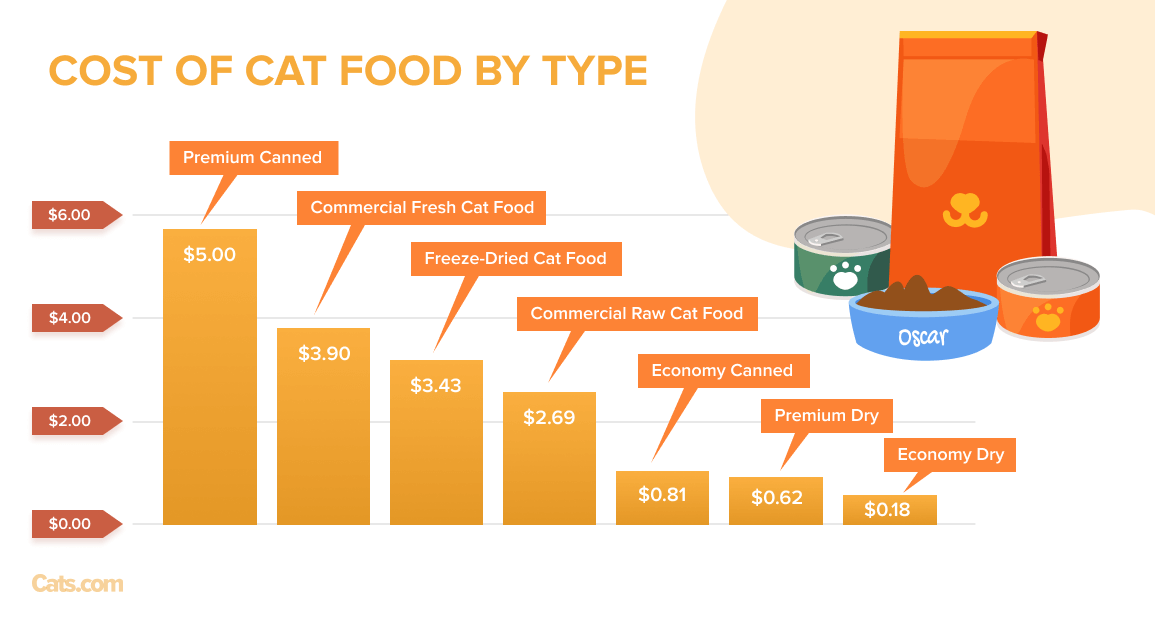
Cat Litter and Supplies
$111-$250+/year
One cat will typically use about 7 lbs. of clay litter each week or 28 pounds per month. However, litter usage varies based on your cat’s health, the type of litter you choose, and your scooping efficiency.
Non-clumping clay litter is the most economical and costs an average of about $0.30 per pound while clumping clay litter ranges from $0.40 to $1 per pound. Crystal cat litter is more expensive, around $2 per pound, but just 7 to 10 pounds is often enough to last a single cat one month. Natural, biodegradable litters are priced all over the spectrum but are typically more expensive than clay litter.
Your costs will go up if you include additional litter box accessories like litter mats, deodorizers, and a dedicated garbage can.
- Litter box liners – $10/year
- Deodorizing spray or powder – $15/year
- Litter scoop – $10
- Litter Genie or trash can – $30
- Litter mat – $25
Additional Resources:
- 12 Best Cat Litter Boxes In 2024 – We Tried Them All
- The 5 Best Cat Litter Mats For Trapping Litter
- 12 Best Cat Litters of 2024
Enrichment
$0-$150+/year
While things like cat trees and scratching posts are often considered optional extras, they are important for your cat’s mental and physical health. Cat trees, scratching posts, interactive toys, and even a leash and harness can help you give your cat the exercise and mental stimulation they need on a daily basis.
You probably won’t need to purchase a cat tree every year, but you may need to replace scratch pads and interactive toys from time to time. Treats used for training can be considered a recurring expense as well.
Total Annual Cost of Owning a Cat
According to our calculations, we estimate total annual cost of owning a Cat to be in the range of $222 – $3,647
Let’s see what goes into keeping a cat on both extremes of this huge spending spectrum.
The low budget doesn’t involve any pet insurance, nor does it involve a single vet visit. The cat is fed a cheap—probably dry—cat food and uses a low-cost clay litter. The cat may have some nice things like a cat tree, scratching post, and ID tag, but these were bought when he came home and they don’t add up to recurring costs every year.
Because this cat doesn’t have pet insurance, a serious illness or accident will be his guardians’ sole responsibility.
Our ultra-expensive feline has a vet checkup twice every year, uses a spot-on flea treatment in the summer, goes for regular professional dental cleanings from an expensive vet, and receives booster shots every three years. She doesn’t have pet insurance, so all of these vet visits are charged to her guardian’s credit card.
She eats a top-of-the-line organic, raw, or human-grade commercial food, possibly subscribing to a meal delivery service like Smalls Cat Food. Her litter box is filled with Pretty Litter crystals or a high-end biodegradable litter. She gets toys, top-of-the-line scratching posts, and new cat trees on a regular basis.
Budget-Friendly Cat Ownership Tips
Sometimes a furry friend wanders into your home and heart before you’ve had a chance to fit cat food into your monthly spending plan. What then?
If you don’t have enough money to lavish your cat with fine foods and gifts, please don’t think that you’re a bad cat guardian. Almost everyone can afford a cat and can afford to raise them well.
Here are a few tips for people who want to keep their cat care budget low.
Know the difference between giving your cat the best and buying things because they makes you feel like a good cat owner.
There’s a whole world of cat care products that only exist to make people feel like they’re doing something good. These items can be fun, but they’re certainly not necessary and most of the time, they are more enjoyable for the human than the cat who’s receiving them.
- Most cat toys – Toys are fun, but most cats are perfectly capable of finding their own toys around the house.
- Cat beds – Cats are just as happy sleeping in a blanket-lined cardboard box as they are snoozing in a sherpa-lined cat tunnel.
- Organic cat food – If you can afford it, spring for organic meats and foods, but if you can’t, remember that non-organic species-appropriate food is much better than organic food that doesn’t honor your cat’s carnivorous needs.
- Store-bought treats – Most cats would be just as happy to eat a chunk of fresh chicken and it would be healthier for them.
Consider Alternatives To Traditional Cat Litter.
Cat litter expenses can add up quickly, so optimizing your litter situation is one of the most powerful areas for improvement.
One of the most economical litter box solutions is swapping out traditional litter for woodstove pellets—also marketed as horse stall bedding. These sawdust pellets are ultra-absorbent and appear to work just as well as popular brands of pine cat litter. The best part is that they cost a tiny fraction of the price of traditional cat litter.
While the average clay litter costs around $0.40 per pound, standard wood pellets cost about $0.17 per pound.
Also Read: Best Cat Litter: Choose the Perfect Litter for Your Cat
When safe to do so, don’t be afraid to give your cat things that don’t have the word “cat” on the package.
It might seem clean and easy to exclusively buy your cat products “made for cats”, but in reality, no cat has a problem using generic products that don’t have pawprints on them.
Until I finally bought a set of food bowls that would look good in photos, my cats ate from vintage metal and ceramic bowls we bought at a thrift store. They still drink water out of an old pot.
Cat-specific food and water bowls and cat water fountains, like many other items in the pet store, are sold at a “love-of-a-pet” markup.
Don’t let your love for your cat delude you into believing that any cat is happier with bowls, beds, treats, and toothbrushes sold specifically for pets. You can find generic versions of many of these products in thrift stores, on Amazon, and anywhere else you might shop for high-value items.
Feed Your Cat Well and Keep Them Safe
Emergency vet bills and taking care of a sick cat are two of the biggest expenses you’ll encounter. It’s impossible to ensure that nothing will ever happen, but you can reduce your cat’s likelihood of getting sick or hurt.
A species-appropriate diet is the single easiest and most affordable means of discouraging obesity, diabetes, and feline lower urinary tract disease. Cats need a high-moisture diet rich in bioavailable protein and minimal carbohydrate matter. If you’re not sure what this means, check out our article on the best cat food.
In addition to keeping your cat healthy with a good diet, you should consider their safety. Prevent accidents by keeping your cat indoors or go for supervised outdoor adventures with a harness and leash.
Owning a Cat Isn’t Cheap, but It’s Not Necessarily as Expensive as Some Suggest.
The cost of keeping a cat ranges from under $200 a year to multiple thousands of dollars annually. Your actual costs will depend on which breed you choose, your cat’s health, the type of food you buy, where you live, your lifestyle choices, and whether or not you invest in pet insurance.
Raising a cat is just like raising a human. There’s no single figure for how much it costs to keep a child healthy and happy—it all depends on what you can afford, what you’re willing to pay, and how good you are at making wise buying decisions.
Your cat’s quality of life hinges less on dollars spent and more on the amount of energy, intelligence, and love you’re willing to give.






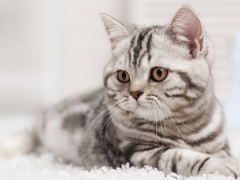

I think the bottom line about owning a cat if time and love… no matter how expensive our beloved cat was, it should have given enough love and as well as respect. Respect connotes time.
Cats make such special companions. I can’t imagine life without them.
The age of the cat also matters. Young cats seldom get sick, but just as with humans most of the medical bills happen in the last year of life so be prepared for that.
Best cat toy is a walnut in the shell. Something about them is irresistible.
Best cat toy is tie-rap. My Cat will play with it for days, throwing it up in the air, doing air shows for me and loves to bite down on it and put the clicks through. He just loves it!!!!! Been playing with them for over 8 years.
Cats are the best. I was trying to see how much caring for a cat would be. My roommate is worried a cat will cost too much. Now, I have enough evidence to show her that cats can be inexpensive.
Some of your costs were over, but vet costs were definitely underrated. Maybe it’s the area you live in, but here in FL, vets are more expensive than human doctors. They will run test after test, running up bills that take senior citizens years to pay off. Even though the owner knows the cat is dying, the vets keep running tests, giving the owners false hope. Been there, done that. Paid almost $2000 to “save” my cat, which anyone with any sense would have known wasn’t going to make it. But the money was more important than being honest with the owner and letting the cat die peacefully. The “treatment” prescribed was starving my cat to death, until I realized what was happening. I then fed him some of his favorite home made food to stop him from starving. I asked for a partial refund from the three vets that treated him. Didn’t hear back from two of them, the other one said I wasn’t a “good fit” for her practice. The pain these vets caused me only added to the sorrow of losing my beloved Tucker. They simply didn’t care. A few years ago, I was at a vet’s office with my sick cat, and his wife, who worked there, was on the phone talking about her purchase of $60,000 in kitchen cabinets. I didn’t make that much money in three years, yet they had no qualms about charging me well over $100 practically every time I took one of my “boys” there. And insurance is worthless, for the most part. They won’t cover “pre-existing conditions, which most cats have unless the insurance is purchased when they are kittens. And I have yet to find any insurance for $20 a month. So, just know, pets are expensive, period. Don’t get one if you can’t afford to care for them properly.
How these companies can charge what they do for the small cans of cat food and various sizes of bags of dry food is beyond my comprehension. Even Ellen and Rachel have no problem gouging their “fans” to make them rich. Some “natural” and/or “organize” merchants charge $22 – $25 for a small bag of their food. Seriously????
I try to give my “kids” (now a male and a female since Tucker passed away) the best care I can. As a senior citizen on a fixed income, I read the labels and what benefits are in the product for them. I buy what I can afford. I can buy a can of tuna for less than a can of wet cat food. Again, seriously???? No, I don’t give them tuna on a regular basis because of the mercury content, only as a treat.
Just like other professions, the pet care industry is a racket. They play on people’s emotions. Pets used to be just that—pets. They stayed outside all year and we kept them warm and fed. They didn’t want to be inside.
I hadn’t planned to go on like this but, once I got started, I found myself unable to stop. People have got to stop buying into what these people are selling. Just like our government, they are taking us for a ride. Hang on!
Thank you for sharing your thoughts and experience. I think there are a lot of people who share your frustration. Take care.
Correction: not “organize”, I meant “organic”. I think “auto spell” filled it in incorrectly.
I live in Michigan..it cost over $450. To spayed a cat ..lab bills are $400. At least..vaccines
,with visit over $250..nail trim every month 10 to $20..cat food $ 4.00 per day plus for good we quality.., then litter, probiotic, Lax gel for hairballs 60$ per month plus grooming..revaluate ur prices..please
Hi Joann, thanks for sharing and suggesting that we reevaluate the expenses mentioned in this article. We’ll keep it on our list of articles to update.
I’ve an e-mail signature that reads “Cats and computers. Bring them into your home and your life is no longer your own.”
I am dismayed that you would refer to vet care as a little luxury. A cat should see a vet at least once a year. As for food, a number of vets have told me that most of the large pet food companies do extensive research for their products. So while people may sneer at Fancy Feast,, it is a good healthy food. Cats don’t need holistic food prepared in kitchens by elves and fairies. Friskies is just fine. The pet industry has gone crazy. I do love my cats and feed them well but I don’t go crazy and feed them quail eggs. They have clean litter boxes (cleaned every day) good food, fresh water every day in clean bowls, many toys and numerous beds and blankets.
Looking at the article again, I think it was inaccurate to describe vet checkups that way. Edited. Thank you for your insights!